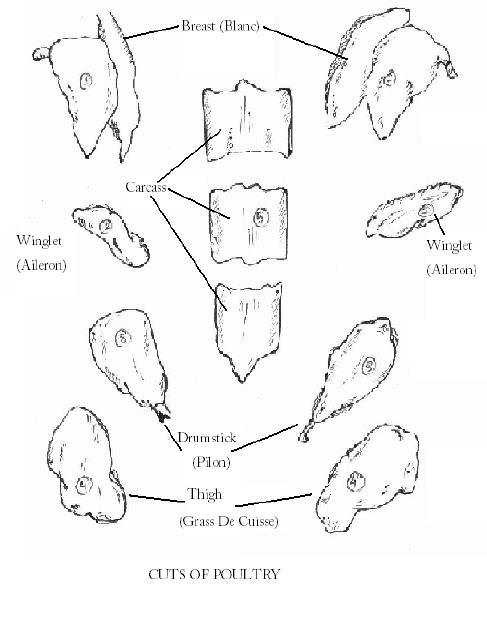Poultry
Poultry is the name even to domestic birds. It includes the different variety and sizes of chicken, turkey, duck and goose.
Classification of poultry:
Identification of poultry:
- soft, floppy, feathers should be all over the body and concentrated under the wings.

- The quills of feather should be easy to pullout.
- The skin should be clean and smooth and no blasting spots.
- Combs and wattle should be small and well develop and the combs being bright red in colour.
- Conformation or the shape of the bird is important and the birds should free from deformity.
- The eyes should prominent and clear.
- It should not have market unpleasant smell.
Food value:
The flesh of poultry is more easily digested then that the other meat. It contents protein and is therefore useful for building and repairing body tissue and providing also the heat and energy.
Accompaniments and garnishes:
- Grilled chicken: – Fry straw potato, devil sauce (Deeping).
- Tandoori chicken: – Laccha salad (onion ring, lemon, green chilly), mint sauce (Deeping).
Garnish- Julian cuts of carrots.
- Chicken korma: – Fresh corriendal leaf (chopped), fried kaju nut (crush),
Julian cuts of ginger and lemon.
- Chicken pokora: – Sprinkle chat masala and mint sauce.
- Chicken curry: – Fresh corriendalchop, jillion cuts of ginger and lemon.
Read more about poultry in India from https://www.poultryindia.co.in/
Cooking methods:
The methods used for poultry depends upon the size of the birds and the nature of the places. Some birds are young tender and lacking of fat; others are through and require moist heat for tenderizing. The characteristic of the flesh have leave to special method of preparation for the special class of poultry.
Young birds are cooked by grill, tan door or roasted as there tender but the nature birds are cooked by moist cooking. Spices are added when flavour as needed and are enreach with fat such as fricassee curry, karma.
Link young birds are fried as it enhances palatability.
| SL. NO. | NAME | WEIGHT | NO. OF
PORTION |
USE |
| 01 | Single body chicken | 300-350 gm | 1 | Roasting and
grilling. |
| 02 | Double body chicken | 450 gm | 2 | Roasting, grilling and tandoori preparation. |
| 03 | Medium chicken | 750 gm- 1 kg | 4 | Roasting, encasserole,
sauces and tandoori. |
| 04 | Large chicken | 1 ½ kg – 2 kg | 6- 8 | Boiling, grassing, galantine and stewing. |
The versatility, the popularity, and the relatively low cost of poultry items make them ideal for all kinds of food service operations, from elegant white-tablecloth restaurants to cafeterias and fast food restaurants. Also, chicken and turkey are becoming very popular among diet-conscious people, because chicken and turkey are lower in fat and cholesterol than other meats. Learning about poultry is, in some ways, easier than learning about meats like beef and lamb. Because chickens, turkeys, and other poultry are much smaller, they are not cut up in such detail. However, poultry has its unique cooking problems, so it is important that the student observe both the similarities and the differences between meat and poultry.
COMPOSITION AND STRUCTURE
The flesh of poultry is muscle tissue, as is the flesh of beef, lamb, veal, and pork. Its composition and structure are essentially the same as those of meat. Remember that muscle tissue is composed of
- Water (about 75%)
- Protein (about 20%)
- Fat (upto 5%)
- Other elements, including carbohydrate, in small quantities.
Remember that the muscle consists of muscle fibers, held together in bundles by connective tissue.
Maturity and Tenderness
Tenderness of a piece of meat – or poultry – is related to connective tissue increases with
- Use or exercise of the muscle.
- Maturity or age of the animal or bird.
- Use or exercise is of less concern in poultry. Most poultry are so young that it is relatively tender throughout. However, there are some differences, discussed in the next section, “light meat”, and “dark meat”.
- Maturity is a major consideration when selecting poultry. Young, tender birds are cooked by dry-heat methods, such as broiling, frying, and roasting, as well as by moist heat to be made palatable.
Maturity is the major factor in categorizing each kind of poultry.
“Light Meat” and “Dark Meat”
A poultry is not divided up into many small cuts, as are meats. Chicken and turkey, however are usually thought of as consisting of two kinds of parts, depending on the colour of the meat. These colour differences reflect other differences:
“Light meat” – breast and wings
- Less fat
- Less connective tissue
- Cooks faster
“Dark meat” – legs (drumsticks and thighs)
- More fat
- More connective tissue
- Takes longer to cook
Duck and game have all dark meat, but the same differences in connective tissue holds true. The cook must observe these differences when preparing poultry.
- Cooking whole birds. Everyone has tasted chicken or turkey breast so dry it was difficult to swallow. In fact, light meat is overcooked more often than not, because it cooks faster than the legs and is done first. In addition, the breast has less fat than the legs, so it tastes much drier when cooked (or overcooked).
A major problem is roasting poultry is cooking the legs to doneness without overcooking the breast. Chefs have devised many techniques to help solve this problem. Here are some of them.
- Roasting breast down for part of the roasting period. Gravity draws fat and moisture to the breast rather than away from it.
- Roasting with fat only, not with water or stock. Fat protects from drying, but moisture washes away protective fat.
- Barding, or covering the breast with a thin layer of pork fat. Usually done with lean game birds.
- Separating breast from leg sections and roasting each for a different time. Often done with large turkeys.
- Cooking poultry parts. Many recipes have been devised especially for certain poultry parts, such as wings, drumsticks, and boneless chicken breast. These recipes take into account the different cooking characteristics of each part. For, example, flattened boneless chicken breasts can be quickly sautéed and remain juicy and tender. Or turkey wings, when braised, release enough gelatin to help make a rich sauce.
Many of these items have especially high customer appeal, especially boneless chicken breast, and are served in the most elegant restaurants. Several of the chicken and turkey recipes are for specific parts. Those that use cut-up whole chicken can easily be adapted for specific parts. For example, you may want to buy whole chickens, braise the leg sections, and reserve the breast for other preparations.
CLASSIFICATION AND MARKET FORMS
The following terms are used to classify poultry:
Kind – the species, such as chicken, turkey, or duck.
Class – the subdivision of kind, depending on age and sex. Table-1 describes kinds and classes of poultry.
Style – the amount of cleaning and processing.
- Live: almost never purchased in food service.
- Dressed: killed, bled, and plucked. Also rarely seen in food service.
- Ready to cook: dressed and eviscerated, with head and feet removed.
- Cut up, or parts.
State of refrigeration –chilled or frozen.
HANDLING AND STORAGE
Fresh poultry
- Fresh poultry are extremely perishable. It should arrive packed in ice until used.
- Ideally, use it within 24 hours of receiving, never more than 4 days.
- Poultry often carry salmonella bacteria. Wash all equipment and cutting surface after handling poultry to avoid contamination of other foods.
Frozen Poultry
- Store frozen poultry at 0oF (-18oC) or lower until ready to thaw.
- Thaw in original wrapper in refrigerator, allowing 1 to 2 days for chickens, 2 to 4 days for larger birds. If pressed for time, thaw in cold, running water in original wrapper.
- Do not refreeze poultry.
DONENESS
Poultry is almost always cooked well done. Chicken and turkey are low in fat, so they become dry and unpalatable when overcooked. Even duck and goose, which are fatty, taste dry and stringy if cooked too long. Many skilled chefs with years of experience can often tell the doneness of a roast chicken or turkey just by looking at it. Until you have gained that much experience, you should rely on other methods.
For Large Roasted Birds
Internal temperature of 180oF (82oC), tested with a thermometer should be inserted into the thickest muscle of the inner part of the thigh, away from the bone. The thigh is tested rather than the breast, because the thigh is the last part of the bird to become fully cooked.
For Smaller Birds, Cooked by Any Method
Doneness is determined in the following ways.
| Kind/Class | Description | Age | Weight Range |
Chicken |
|||
Rock Cornishgame hen |
Specially breed of young chicken, very tender and delicate. | 5-6 weeks | ¾ – 2lb
(0.34-0.9 kg) |
Broiler or fryer |
Young chicken of either sex. Tender flesh and flexible cartilage. Smooth skin. | 9-12 weeks | Broiler: 1½ -2½lb
(0.7-1.1kg) |
Roaster |
Young chicken of either sex. Tender flesh and smooth skin, but less flexible cartilage. | 3-5 months | 3½ – 5lb
(1.6-2.3 kg) |
Capon |
Castrated male chicken. Flesh very tender and well flavoured. Large breast. Expensive. | Under 8 months | 5-8lb
(2.3-3.6kg) |
Hen or fowl |
Mature female. Tough flesh and coarse skin. Hardened breast bone cartilage. | Over 10 months | 3 ½ – 6lb
(1.6-2.7kg) |
Cock or rooster |
Mature male. Coarse skin. Tough, dark meat. | Over 10 months | 4-6lb
(1.8-2.7kg) |
Turkey |
|||
Fryer-roaster |
Young bird of either sex. Tender flesh, smooth skin, and flexible cartilage. | Under 16 weeks | 4-9lb
1.8-4 kg |
Young turkey(hen or tom) |
Young turkeys with tender flesh but firmer cartilage. | 5-7months | 8-22lb
(3.6-10kg) |
Yearling turkey |
Fully matured turkey that is still reasonably tender. | Under 15months | 10-30lb
(4.5-14kg) |
Mature turkey or old turkey (hen or tom) |
Old turkey with tough flesh and coarse skin. | Over 15months | 10-30lb
(4.5-14kg) |
Broiler or fryer duckling |
Young tender duck with soft bill and windpipe. | Under 8 weeks | 2-4lb
(0.9lb-1.8kg) |
Roaster duckling |
Young tender duck with bill and windpipe that are just starting to harden. | Under 16 weeks | 4-6lb
(1.8-2.7kg) |
Mature duck |
Old duck with tough flesh and hard bill and windpipe. | Over 6months | 4-10lb
(1.8-4.5kg) |
Goose |
|||
Young goose |
Young bird with tender flesh. | Under 6months | 6-10lb(2.7-4.5kg) |
Mature goose |
Tough old bird. | Over 6months | 10-16lb(4.5-7.3kg) |
Guineas |
|||
Young guinea |
Domestic relatives of the pheasant. | About 6months | ¾ -1½lb
(0.34-0.7kg) |
Mature guinea |
Young birds are tender, old ones are tough. | Up to 12months | 1-2lb
(0.45-0.9kg) |
Pigeons |
|||
Squab |
Very young pigeons with light, tender meat. | 3-4 weeks | Under 1lb(0.45kg) |
Pigeon |
Older pigeons with tough, dark meat. | Over 4 weeks | 1-2lb(0.45-0.9kg) |
- Looseness of joints. The leg will move freely in its socket.
- Clear juices. Juices inside the cavity of a roasted bird will be clear yellow rather than cloudy and red or pink.
- Flesh separating from bone. Muscles will begin to pull away from bones, especially breastbone and leg bones. Excessively shrunken flesh means it is overcooked and dry.
- Firmness to touch. Test with finger pressure as you would a steak. Especially useful method for sautéed boneless chicken breasts.
Not recommended: do not test by piercing deeply with fork and twisting the flesh. Too many valuable juices will be lost.
TRUSSING METHOD
Trussing means trying the legs and wings against the body to make a compact, solid unit. It has too main purposes:
- Even cooking. Extended legs and wings cook too quickly.
- More attractive appearance, especially when presented or served whole or carved in the dinning room.





